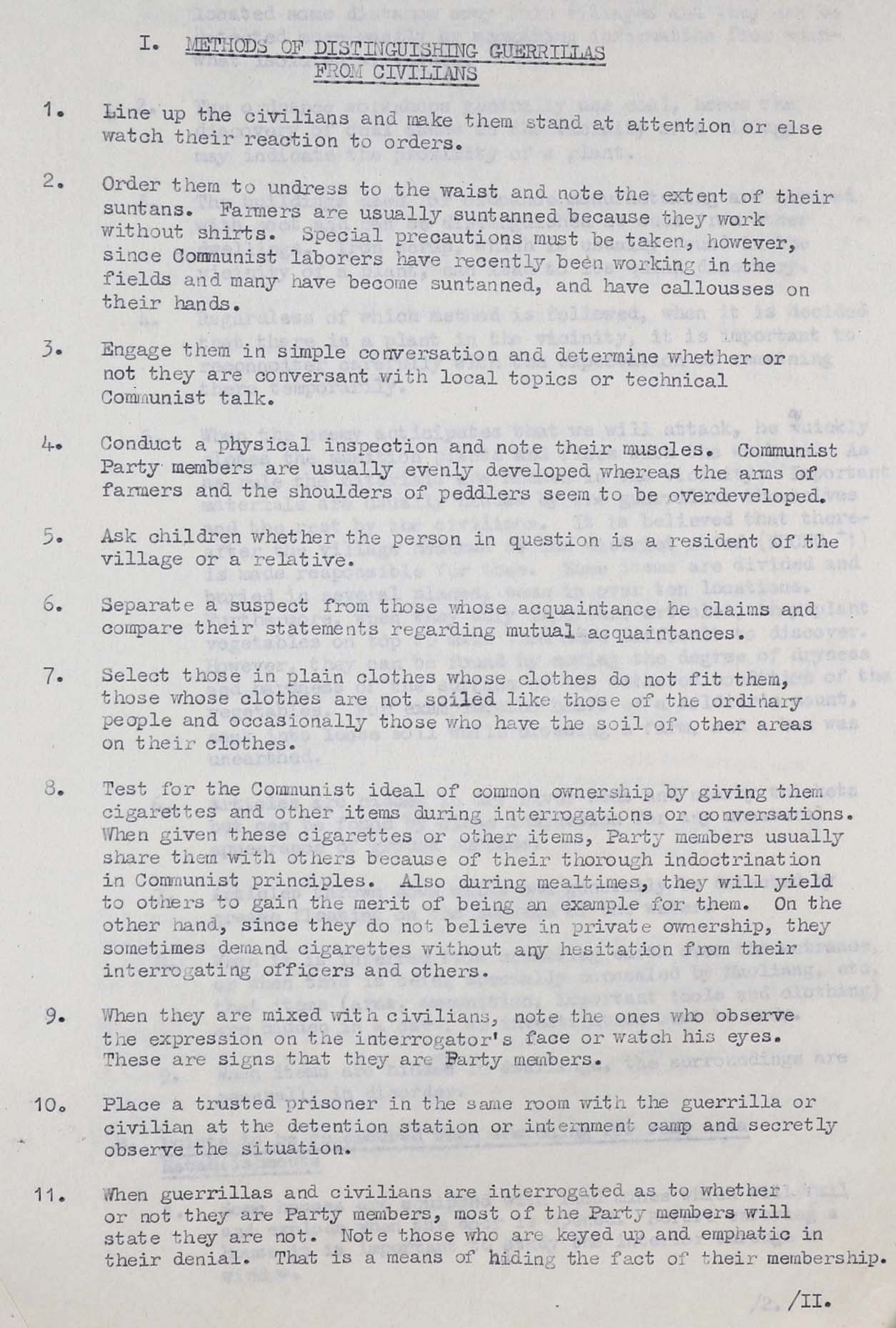
Report entitled ‘METHODS OF DISTINGUISHING GUERRILLAS FROM CIVILIANS’ by the Japanese army, captured and translated by the US Army’s Pacific Military Intelligence Research (PACMIR). 1943-45. Catalogue ref: WO 208/4398
From 1937 to 1945, China and Japan fought in the second Sino-Japanese War as part of the Second World War. During this war, the KMT and CCP formed a precarious united front. The CCP successfully used guerrilla tactics against the Japanese army and recruited support in the rural population. In contrast, KMT forces were weakened by the war and the KMT government struggled with the economic fallout of the conflict.
Transcript
METHODS OF DISTINGUISHING GUERRILLAS FROM CIVILIANS
- Line up the civilians and make them stand at attention or else watch their reaction to orders.
- Order them to undress to the waist and note the extent of suntans. Farmers are usually suntanned because they work without shirts. Special precautions must be taken, however, since Communist laborers have recently been working in the fields and many have become suntanned, and have callouses on their hands.
- Engage them in simple conversation and determine whether or not they are conversant with local topics or technical Communist talk.
- Conduct a physical inspection and note their muscles. Communist Party members are usually evenly developed whereas the arms of farmers and the shoulders of peddlers seem to be overdeveloped.
- Ask children whether the person in question is a resident of the village or a relative.
- Separate a suspect from those whose acquaintance he claims and compare their statements regarding mutual acquaintances.
- Select those in plain clothes whose clothes do not fit them, those whose clothes are not soiled like those of the ordinary people and occasionally those who have the soil of other areas on their clothes.
- Test for the Communist ideal of common ownership by giving them cigarettes and other items during interrogations or conversations. When given these cigarettes or other items, Party members usually share them with others because of their thorough indoctrination in Communist principles. Also during mealtimes, they will yield to others to gain the merit of being an example for them. On the other hand, since they do not believe in private ownership, they sometimes demand cigarettes without any hesitation from their interrogating officers and others.
- When they are mixed with civilians, note the ones who observe the expression on the interrogator’s face or watch his eyes. These are signs that they are Party members.
- Place a trusteed prisoner in the same room with the guerrilla or civilian at the detention station or internment camp and secretly observe the situation.
- When guerrillas and civilians are interrogated as to whether or not they are Party members, most of the Party members will state they are not. Note those who are keyed up and emphatic in their denial. That is a means of hiding the fact of their membership.
« Return to The Chinese Civil War
Task 4: Fighting tactics
Look at source 4 and answer these questions:
- What does this source infer about the fighting tactics of the Communist army (also known as the Eighth Route Army)? List at least three things.
- Research a definition of ‘guerrilla warfare’ and compare your list.
- How do CCP tactics explain its mass support amongst peasant communities in China?
- What do you think made these fighting tactics difficult for the Japanese troops as well as the KMT to combat?
- Why do you think the Japanese Army created this report?
- Why do you think the British government has extracted this report?
